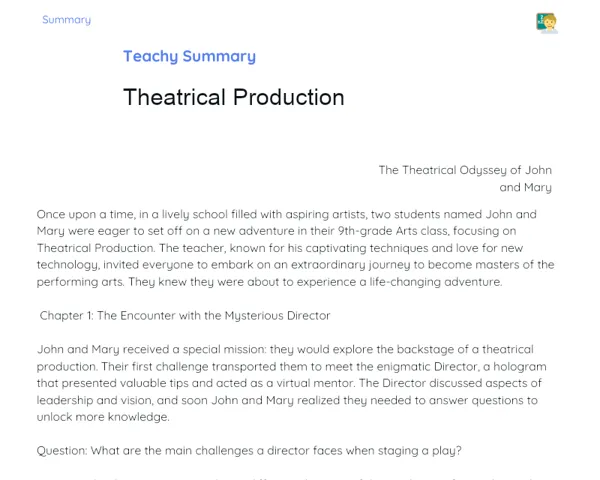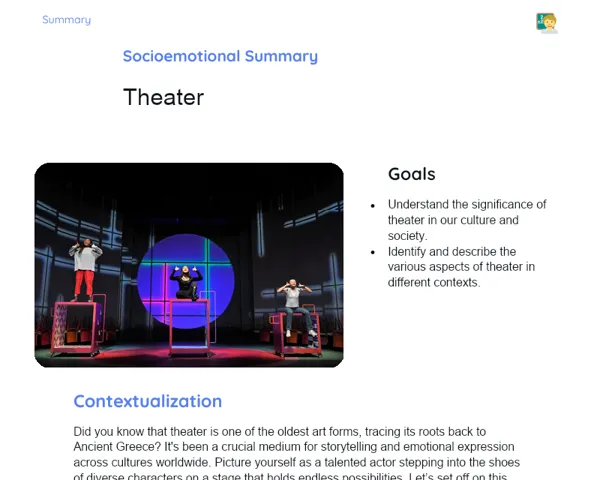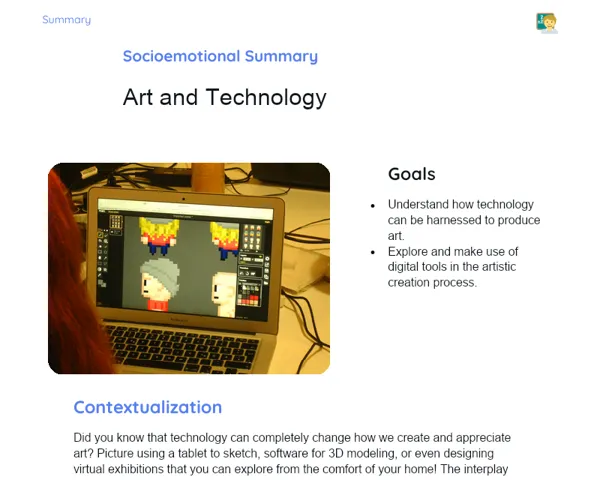Socioemotional Summary Conclusion
Goals
1. Recognize and understand the significance of different body parts in performing dance movements.
2. Develop the ability to identify and describe various body movements used in dance.
3. Establish connections between emotions and body language through dance.
4. Enhance self-awareness and self-regulation through dance practice.
Contextualization
Did you know that dance is among the oldest forms of human expression? Since ancient times, individuals have utilized their bodies to weave stories, express emotions, and forge connections with others. The enchanting beauty of dance is that it allows you to communicate feelings without uttering a word, using solely movements. In this lesson, we will delve into how various parts of the body collaborate to create smooth and meaningful movements. Get ready to experience the transformative power of dance!
Exercising Your Knowledge
Locomotor and Non-Locomotor Movements
Locomotor movements involve the body moving from one location to another, such as walking, running, jumping, and hopping. Non-locomotor movements occur while remaining in a single spot, like swaying, spinning, bending, and stretching. Grasping these movements is crucial for dance, as they help in crafting dynamic and expressive sequences.
-
Locomotor Movements: Recognize how actions like walking, running, and jumping navigate your body through space, akin to travelling from one point to another.
-
Non-Locomotor Movements: Picture a tree swaying in the breeze. Though it doesn’t leave its place, its branches sway, spin, and stretch. This mirrors your body's actions with non-locomotor movements.
-
Relevance: Blending locomotor and non-locomotor movements cultivates a diverse dance, enabling you to convey a richer narrative with just your body.
Rhythm and Tempo
Rhythm denotes the pattern of movement and sound over time, fundamental in marrying movements in dance. Tempo pertains to the pace at which these movements are executed, spanning from quick to slow. Together, rhythm and tempo create the framework and emotional depth of dance.
-
Rhythm: Consider your heartbeat. Just like it, rhythm ensures harmony and synchronization in dance.
-
Tempo: Reflect on a song's tempo. It can be as lively as a sprint or as leisurely as a stroll. This tempo injects emotion and energy into the dance.
-
Relevance: Grasping rhythm and managing tempo are indispensable for dancing in harmony with the music and reflecting the intended emotion.
Space and Shape
Space denotes the physical environment where dance occurs and how the dancer navigates within it. Shape represents the arrangement of the body in that space, which can be straight, curved, or a blend of both. Comprehending space and shape enables dancers to creatively and expressively utilize their surroundings.
-
Space: Envision the stage as a vast canvas where you can illustrate with your body. Utilizing the entire space renders your dance more captivating and expressive.
-
Shape: Picture your body as a work of art. The positions you create can be straight lines, curves, or a mix of both, each signifying different meanings.
-
Relevance: Optimally using space and forming varied shapes helps express different emotions and narratives through dance.
Key Terms
-
Locomotor Movements: Movements that entail transferring the body from one place to another, including walking, running, jumping, and hopping.
-
Non-Locomotor Movements: Movements undertaken without relocating, such as swaying, spinning, bending, and stretching.
-
Rhythm: The pattern of movement and sound across time, crucial for synchronization in dance.
-
Tempo: The pace at which movements are performed, categorizing from fast to slow.
-
Space: The physical surroundings where dance takes place and the manner in which the dancer moves within it.
-
Shape: The configuration of the body in space, which can be linear, curved, or a blend of both.
For Reflection
-
How do the different body movements aid in expressing various emotions during dance?
-
In what ways do rhythm and tempo shape your emotions while dancing?
-
How can you leverage dance to enhance your body awareness and emotional management in other aspects of your life?
Important Conclusions
-
Dance serves as a potent form of emotional and artistic expression, enabling you to convey feelings without the need for words.
-
Dance movements include both locomotor and non-locomotor types, with each body part playing a key role in creating these movements.
-
Rhythm, tempo, space, and shape are critical components of dance that communicate emotions and narratives.
-
Regular dance practice fosters self-awareness, self-regulation, and social skills, making it an invaluable tool for socio-emotional growth.
Impacts on Society
In various cultures, dance is embraced as a form of celebration, ritual, and therapy. Today, it thrives as a popular activity at parties, gyms, and schools, enhancing both physical and mental wellness. By learning to dance, you not only gain a new skill but also discover a lively and enjoyable outlet for expressing your emotions and connecting with others.
On an emotional front, dance provides a safe and creative avenue to explore and comprehend your feelings. It allows you to release pent-up emotions and foster improved body awareness, ultimately leading to greater self-acceptance and confidence. Hence, dance contributes not only to your physical health but also enhances your emotional and mental well-being.
Dealing with Emotions
To manage your emotions during your dance journey, try this exercise based on the RULER method:
Recognize: Before you begin dancing, take a moment to tune into your feelings. Are you feeling excited? Anxious? Melancholic? Understand: Reflect on what might be triggering these emotions. Perhaps you are feeling nervous about a performance or excited about mastering a new skill. Name: Label your emotion. Are you feeling joyful, frustrated, anxious, etc.? Express: Utilize dance as an outlet for that feeling. If you're happy, make expansive and energetic movements. If you're sad, explore slower and more delicate movements. Regulate: After your dance, notice how the activity influenced your emotions. Do you feel more relaxed? Revitalised? Use this insight to better manage your feelings in everyday situations.
This exercise not only hones your dance abilities but also nurtures your emotional intelligence, offering a healthy means of navigating your emotions.
Study Tips
-
Practice dance movements at home: Allocate a few minutes each day to practice what you’ve learned in class. This will bolster your confidence and coordination.
-
Watch dance videos: Explore platforms like YouTube to view diverse dance styles and grasp how various dancers convey emotions through their movements.
-
Engage with friends and family: Share your insights regarding dance movements and their emotional connections with loved ones. This not only reinforces your learning but also encourages enriching exchanges of experiences and feelings.



